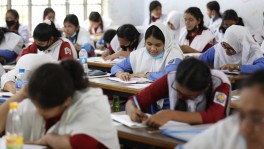Curious case of Bangladesh in Covid South Asia
Among the eight South Asian countries, it ranks fourth in terms of deaths for every 100 people

If one checks on various Covid-19 trajectories in South Asian countries, Bangladesh appears a curious case.
Bangladesh has a very high infection rate in the region – actually second highest after Afghanistan. But it does not have that many deaths.
Among the eight South Asian countries, it ranks fourth in terms of deaths for every 100 people. India, Afghanistan and Pakistan have higher death rates than us.
But the data on recovery tells a gloomy story. Its recovery rate is lower than all neighbouring countries except Nepal and Afghanistan.
For some reasons, patients hospitalised are not recovering faster than in most South Asian countries.
And the most shocking side of the story is our testing capacity. Despite being an emerging economy in Asia, Bangladesh lags behind all South Asian countries except Afghanistan in conducting coronavirus tests.
In the region, Sri Lanka, Bhutan, the Maldives and Nepal are fighting Covid-19 well. They have low death and infection rates. They have conducted more tests than their neighbours.
India, the biggest country in the region in terms of economy and population, however, cannot fight well like others, data shows.
War torn Afghanistan is facing the worst situation.

Covid-19 cases continue to rise rapidly, with records for the number of new daily cases across the region. South Asia's three most populous countries – India, Pakistan, and Bangladesh – are leading the way.
Experts blame a lack of timely and effective measures for the rise of new cases in the three countries. In their views, Sri Lanka, the Maldives and Bhutan have fared well with effective and timely measures to contain the spread of the virus.
Yet, one thing is still mysterious. The poverty-stricken densely populated South Asian countries have lower death toll compared to the global death rate of 4.97 percent. In South Asia, the highest death rate recorded is by India at 3.1 percent.
Health experts point to South Asia's young demographics as a potential reason why the total number of deaths – if they are being accurately recorded – is not as high as it could be.
But there is a flip side to having a young population.
The latest Unicef report fears decades of progress on children's health, education and other priorities risks being wiped out.
Of all the countless lives upended by Covid-19, those of 600 million children in South Asia are surely among those affected most profoundly.
Unicef says the coronavirus could push 120 million children in South Asia into poverty – joining 240 million other children in the region.
Around 430 million children cannot go to school and most do not have adequate connectivity to study remotely. Domestic abuse against children is on the rise. And as remittances and tourism dry up, households are spending less on good nutrition, says the report.
"The side effects of the pandemic, including the lockdown and other measures, have been damaging for children in numerous ways," says Jean Gough, Unicef Regional Director for South Asia.


 Keep updated, follow The Business Standard's Google news channel
Keep updated, follow The Business Standard's Google news channel
















